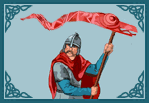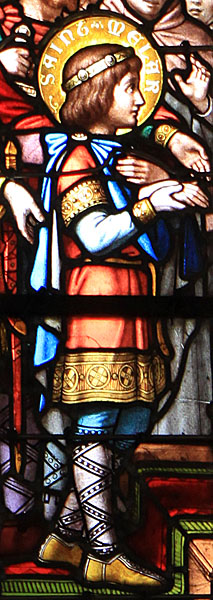 |
 |
|||
|
|
Melor was the son of King
Meliau of Cornuaille, and his wife, Aurelia, daughter of Waroc,
King of Broerec. When Meliau inherited the Throne, Rivod
his brother, did not get a share of the kingdom, or
if he did, desired more. For, during an argument with Meliau, he
treacherously stabbed him and seized control of the kingdom as well as the
young heir, Melor. The uncle would have put him to death but for the
intervention of some of the Breton barons. He therefore contented himself with
cutting off the boy's right hand and left foot, so as to incapacitate
him and prevent him from becoming a pretender to the Throne. For, according
to Celtic tradition, anyone with a bodily defect which prevented them from
riding a horse or wielding a sword, was ineligible to rule.
However, the affection of the Royal household for the young
prince led them to have a silver hand and brazen foot fitted to the
stumps, whereupon the boy was miraculously able to employ these metal
limbs as though they were flesh and bone. For his own safety, Melor was
then sent to Quimper, and placed in the monastery founded by St. Corentin,
under the care of a man named Cerialtan. One day, Melor and other boys were gathering nuts in a
wood. His comrades made little piles of hazel nuts, and brought them to
Melor, who took them with his silver hand. When he returned home, to the
amazement of the good folk in the street, they saw his silver hand
miraculously pass straight through the closed grating of the door, as he
cast away the broken nut-shells. Later, whilst playing with a toy
catapult, Melor shot a bolt which penetrated a rock. When he withdrew the
bolt, a spring of water gushed forth, and it can still be seen today at
Meilars, near Pont-Croix, in Finistere. As well as shooting, Melor also
began to ride and to fight. News of these wonders reached the evil Rivod and
he became worried by the child's prowess of arms and growing popularity.
So he sent for Cerialtan, Melor's foster-father, and
promised him as much land as he could see from the top of Mount Coc (Mount Frugy)
if he
would do away with the lad. Cerialtan was reluctant to accept: he had brought the
young Prince up as his own son after all. However, his wife's greed was
excited and she quickly persuaded him that it was his own family that
should come first. So Cerialtan agreed to bring King Rivod, Melor's head.
Meanwhile, Cerialtan's wife was having second thoughts, and told Melor
that he was in great danger and the two of them must flee. So, whilst her husband was
out, they left. Crossing the Arré Moutains, they sought safety at at Castellum Bocciduum
(Beuzit) in Domnonée, with the the prince's aunt and her husband, King Conomor of
Poher. Rivod was incensed,
but he dared not complain to his powerful brother-in-law. He therefore
urged Cerialtan to use guile to entice the boy away. Cerialtan,
accordingly, went to Bocciduum with his son, Justan, who had been Melor's
play-fellow and to whom he was rather attached. Desirous of seeing her family again, Cerialtan's wife met with
them and persuaded them to abandon their grisly task. Though the two
agreed, the lady was still not sure of their intent and refused to let
still-ignorant Melor sleep in their room when he asked for their
protection. For two nights, she held out before Cerialtan became angry and
she was forced to consent. Having thus persuaded Melor, at least, of their
good intentions, the treacherous
foster-father put the two boys to bed; but, in the dead of night, he crept into
the room and cut off the poor little prince's head as he slept. Rousing his
own son, Cerialtan and Justan fled with the severed head. However, as
they were climbing over the castle wall, Justan's foot caught and he fell
to his death. Cerialtan, meanwhile, pushed on till he reached Kerlean,
near Carhaix, when, exhausted and parched with thirst, he halted. Putting
down Melor's head, he bemoaned his misfortune. Whereupon the dead head spoke
to him and said, "Cerialtan, drive thy staff into the soil and water
will spring up". Much astonished, yet hoping at least to quench his
thirst, the murderer complied. A spring at once appeared and the staff
took root, throwing out branches immediately to become a great tree. On
reaching Rivod's palace, Cerialtan delivered up the head and demanded
the price of his crime. Delighted with his trophy, Rivod confirmed their
agreement. Cerialtan climbed Mount Coc (Mount Frugy) in order to claim all
the land he could see, but on reaching the summit he was miraculously
struck blind! St. Melor's body was buried at Vicus
Maioci (Guimaec) but it refused to stay in the ground and was placed in a
cart ready for reburial elsewhere. Two untamed bulls took it away, but, at
Lanmeur where the spring had formed, the beasts refused to go further.
Melar was buried there and Lanmeur church was built around his shrine
which can still be seen there today. English tradition, however, indicated
that the relics came to Amesbury Abbey in the 10th century, probably when
so many Bretons fled to seek protection amongst the Anglo-Saxons. They
were placed on the high altar and refused to budge, apparently because St.
Melar wished to stay in Wiltshire. The Breton monks were paid off and the
body of Melor remained at Amesbury. There are also churches dedicated to
him in Cornwall, at Mylor and Linkinhorne. Melor's feast day is 1st
October. Records of St. Melor date back to the 11th century. He could be historic.
|
|||
| © Nash Ford Publishing 2006. All Rights Reserved. | ||||





 St. Melor, King of Cornouaille
St. Melor, King of Cornouaille